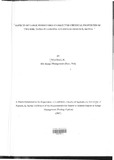| dc.description.abstract | Livestock and wildlife co-exist throughout the semi-arid ecosystems of the world. There
is increasing emphasis on management activities that are both sustainable and more
compatible with native biodiversity conservation. Various factors determine the structure
and function of savannahs. The study investigated and compared the grazing effects of
large herbivores on selected chemical properties of two soils types in Laikipia savannah
ecosystem of Kenya. The main objective was to contribute to the understanding of the
impact of grazing by large herbivores on nutrient content in Laikipia savannah rangeland.
The study tested the following hypotheses:
1. Herbivores affect the cycling of nitrogen and phosphorus, accumulation of
organic matter, C/N ratio and pH in both red sandy loams and black cotton soils.
2. Herbivores affect sequential phosphorus fractionation in both red sandy loams and
black cotton soils
The experimental treatments included glades in the grazed area, bush land in the grazed
area where the exclosures (which exclude all large herbivores) were used as the control
for grazing. Glades are former cattle kraals which were abandoned for several decades of
years. In each type of soil, the treatments were replicated three times. The soil sampling
design involved SOxSO m2 plots, diagonal line transects were run and sampling done
every 16 m. The samples from each plot were mixed to make a composite sample.
With or without grazing herbivores, the black and red soils are different in terms of the
concentration of N, P, C/N ratio and organic matter due to differences in inherent soil
fertility. The results of effects of large herbi vores on N,P,C/N ratio and organic matter
therefore indicate that the two soil types were different, with black cotton soils having
higher contents of N, C, organic matter and C/N ratio at P<O.OS. The C and N correlation
coefficient was very high (r2>0.9) in all treatments, indicating a strong and positive
relationship between the two variates. Total P was not significantly different between the
two soils. The pH was slightly acidic to neutral in the bush land and neutral to slightly
alkaline in the glades. The grazing treatment in glade indicated a trend of increased N, C,
CIN ratio and organic matter and decreased P, while the bush land grazing treatment
appears to lead to a trend of lower N, C, C/N ratio, organic matter, and total P
Results of effects of large herbivores on sequential phosphorus fractionation also
indicated differences between the two soils. Organic P was higher in the black cotton
soils glades than in red sandy loams glades while inorganic P was higher in the red sandy
loams glades LInd bush land than in the black cotton soils. The grazing treatment was not
significantly different although it appears that the glade grazing treatment led to a trend
of increased sequential P fractions, while bush grazing treatment led to a trend of
decreased sequential P fractions.
In conclusion glades are enriched with nutrients in expense of bush. The black cotton soil
has higher amounts of N, C, C/N ratio and organic matter compared to the red sandy
10a111s but relatively lower amounts of P and P fractions. This suggests differences in
nutrient limitation between the two types of soils. While grazing treatment have positive
effects on glade soils and negative effects on bush land in relation to the studied nutrients
elements.
The study recommends that the frequency of relocation and abandonment of the livestock
boma should be reviewed in order to increase the size of the area with high quality forage
and low predation risk. Herbivores play an important function in the savannah ecosystem
by facilitating the accumulation of major nutrients. The apparent decrease of nutrients in
grazed bush lands whether on black cottons soils or in red soils is possibly an indication
that grazing treatment was too light or that more time was required to accumulate the
nutrients in form of glades or herbivore bedding grounds. Hence it is important to support
herbivore grazing and in particular the coexistence of wildlife and livestock in African
savannah ecosystems. | en |

